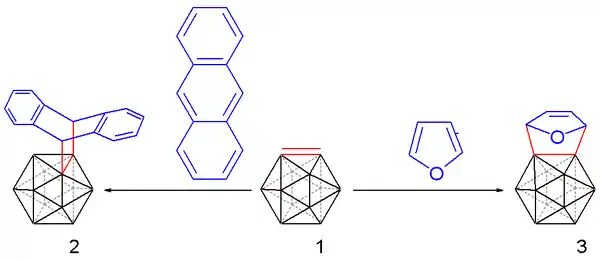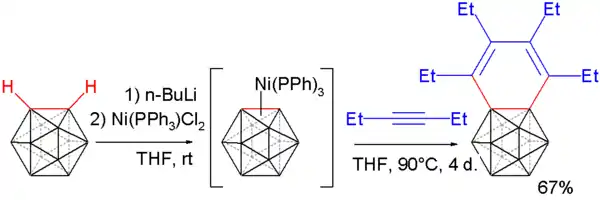Carboryne
In organoboron chemistry, a carboryne is an unstable derivative of ortho-carborane with the formula B10C2H10.[1] They are also called 1,2-dehydro-o-carboranes. The hydrogen atoms on the C2 unit in the parent o-carborane are missing. The compound resembles and is isolobal with benzyne.[2][3][4] A carboryne compound was first generated in 1990 starting from o-carborane. The hydrogen atoms connected to carbon are removed by n-butyllithium in tetrahydrofuran and the resulting lithium dianion is reacted with bromine at 0 °C to form the bromo monoanion.
Heating the reaction mixture to 35 °C releases carboryne, which can subsequently be trapped with suitable dienes:
such as anthracene (to afford a triptycene-like molecule) and furan in 10 to 25% chemical yield.
Carborynes react with alkynes to benzocarboranes [5][6] in an adaptation of the above described procedure. O-carborane is deprotonated with n-butyllithium as before and then reacted with dichloro-di(triphenylphosphino) nickel to a nickel coordinated carboryne. This compound reacts with 3-hexyne in an alkyne trimerization to the benzocarborane.
Single crystal X-ray diffraction analysis of this compound shows considerable bond length alternation in the benzene ring (164.8 pm to 133.8 pm) ruling out aromaticity.
See also
References
- Zhao, Da; Xie, Zuowei (2016). "Recent advances in the chemistry of carborynes". Coordination Chemistry Reviews. 314: 14–33. doi:10.1016/j.ccr.2015.07.011.
- Gingrich, H. L.; Ghosh, T.; Huang, Q.; Jones, M. (1990). "1,2-Dehydro-o-carborane". Journal of the American Chemical Society. 112 (10): 4082–4083. doi:10.1021/ja00166a080.
- Jemmis, E. D.; Kiran, B. (1997). "Structure and Bonding in B10X2H10 (X = C and Si). The Kinky Surface of 1,2-Dehydro-o-Disilaborane". Journal of the American Chemical Society. 119 (19): 4076–4077. doi:10.1021/ja964385q.
- Kiran, B.; Anoop, A.; Jemmis, E. D. (2002). "Control of Stability through Overlap Matching: closo-Carboranes and closo-Silaboranes". Journal of the American Chemical Society. 124 (16): 4402–4407. doi:10.1021/ja016843n. PMID 11960469.
- Deng, L.; Chan, H.-S.; Xie, Z. (2006). "Nickel-Mediated Regioselective [2 + 2 + 2] Cycloaddition of Carboryne with Alkynes". Journal of the American Chemical Society. 128 (24): 7728–7729. doi:10.1021/ja061605j. PMID 16771473.
- Jemmis, E. D.; Anoop, A. (2004). "Theoretical Study of the Insertion Reactions of Benzyne- and Carboryne- Ni Complexes" (PDF). Maui High Performance Computing Center Application Briefs. Air Force Maui Optical & Supercomputing Site (AMOS). 2004: 51. Archived from the original (PDF) on 2006-07-13.


